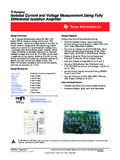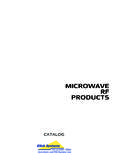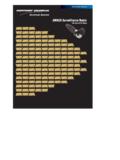Transcription of AD202/AD204 Low Cost, Miniature Isolation …
1 REV. DInformation furnished by analog devices is believed to be accurate andreliable. However, no responsibility is assumed by analog devices for itsuse, nor for any infringements of patents or other rights of third parties thatmay result from its use. No license is granted by implication or otherwiseunder any patent or patent rights of analog Technology Way, Box 9106, Norwood, MA 02062-9106, : 781/329-4700 : 781/326-8703 analog devices , Inc., 2002 Low Cost, MiniatureIsolation AmplifiersFEATURESS mall Size: 4 Channels/lnchLow Power: 35 mW (AD204)High Accuracy: Max Nonlinearity (K Grade)High CMR: 130 dB (Gain = 100 V/V)Wide Bandwidth: 5 kHz Full-Power (AD204)High CMV Isolation : 2000 V pk Continuous (K Grade)(Signal and Power)Isolated Power OutputsUncommitted Input AmplifierAPPLICATIONSM ultichannel Data AcquisitionCurrent Shunt MeasurementsMotor ControlsProcess Signal IsolationHigh Voltage Instrumentation AmplifierGENERAL DESCRIPTIONThe AD202 and AD204 are general purpose, two-port, trans-former-coupled Isolation amplifiers that may be used in a broadrange of applications where input signals must be measured,processed, and/or transmitted without a galvanic industry standard Isolation amplifiers offer a completeisolation function, with both signal and power Isolation providedfor in a single compact plastic SIP or DIP style package.
2 Theprimary distinction between the AD202 and the AD204 is thatthe AD202 is powered directly from a 15 V dc supply while theAD204 is powered by an externally supplied clock, such as therecommended AD246 Clock AD202 and AD204 provide total galvanic Isolation betweenthe input and output stages of the Isolation amplifier throughthe use of internal transformer-coupling. The functionally com-plete AD202 and AD204 eliminate the need for an external,user-supplied dc-to-dc converter. This permits the designerto minimize the necessary circuit overhead and consequentlyreduce the overall design and component design of the AD202 and AD204 emphasizes maximumflexibility and ease of use, including the availability of anuncommitted op amp on the input stage. They feature a bipolar 5 V output range, an adjustable gain range of from 1V/V to100 V/V, max nonlinearity (K grade), 130 dB ofCMR, and the AD204 consumes a low 35 mW of functional block diagrams can be seen in Figures 1a and HIGHLIGHTSThe AD202 and AD204 are full-featured isolators offeringnumerous benefits to the user:Small Size: The AD202 and AD204 are available in SIP andDIP form packages.
3 The SIP package is just " wide, givingthe user a channel density of four channels per inch. The isolationbarrier is positioned to maximize input to output spacing. Forapplications requiring a low profile, the DIP package provides aheight of just ".High Accuracy:With a maximum nonlinearity of the AD202K/AD204K ( for the AD202J/AD204J)and low drift over temperature, the AD202 and AD204 providehigh Isolation without loss of signal Power:Power consumption of 35 mW (AD204) and75 mW (AD202) over the full signal range makes these isolatorsideal for use in applications with large channel counts or tightpower Bandwidth:The AD204 s full-power bandwidth of 5 kHzmakes it useful for wideband signals. It is also effective in appli-cations like control loops, where limited bandwidth could resultin Common-Mode Performance:The AD202K/AD204K provide 2000 V pk continuous common-mode isola-tion, while the AD202J/AD204J provide 1000 V pk continuouscommon-mode Isolation .
4 All models have a total common-modeinput capacitance of less than 5 pF inclusive of power results in CMR ranging from 130 dB at a gain of 100 dB to104 dB (minimum at unity gain) and very low leakage current(2 mA maximum).Flexible Input:An uncommitted op amp is provided at theinput of all models. This provides buffering and gain as required,and facilitates many alternative input functions including filtering,summing, high voltage ranges, and current (transimpedance) Power:The AD204 can supply isolated power of V at 2 mA. This is sufficient to operate a low-drift inputpreamp, provide excitation to a semiconductor strain gage, orpower any of a wide range of user-supplied ancillary AD202 can supply V at mA, which is sufficient tooperate adjustment networks or low power references and opamps, or to provide an open-input D 2 AD202/AD204 SPECIFICATIONSM odelAD204 JAD204 KAD202 JAD202 KGAINR ange1 V/V 100 V/V**Error typ ( 4% max)**vs. Temperature 20 ppm/ C typ ( 45 ppm/ C max)**vs.
5 Time 50 ppm/1000 Hours**vs. Supply Voltage (G = 1 V/V)1 max max max maxNonlinearity vs. Isolated Supply Load **INPUT VOLTAGE RATINGSI nput Voltage Range 5 V**Max lsolation Voltage (Input to Output)AC, 60 Hz, Continuous750 V rms1500 V rms750 V rms1500 V rmsContinuous (AC and DC) 1000 V Peak 2000 V Peak 1000 V Peak 2000 V PeakIsolation-Mode Rejection Ratio (IMRR) @ 60 HzRS 100 W (HI and LO Inputs) G = 1 V/V110 dB110 dB105 dB105 dB G = 100 V/V130 dB**RS l kW (Input HI, LO, or Both) G = 1 V/V104 dB min104 dB min100 dB min100 dB min G = 100 V/V110 dB min** Leakage Current Input to Output @ 240 V rms, 60 Hz2 mA rms max**INPUT IMPEDANCED ifferential (G = 1 V/V)1012 W**Common-Mode2 GW pF**INPUT BIAS CURRENTI nitial, @ 25 C 30 pA**vs. Temperature (0 C to 70 C) 10 nA**INPUT DIFFERENCE CURRENTI nitial, @ 25 C 5 pA**vs. Temperature (0 C to 70 C) 2 nA**INPUT NOISEV oltage, Hz to 100 Hz4 mV p-p**f > 200 Hz50 nV/ Hz**FREQUENCY RESPONSEB andwidth (VO 10 V p-p, G = 1 V 50 V/V)5 kHz5 kHz2 kHz2 kHzSettling Time, to 10 mV (10 V Step)1 ms**OFFSET VOLTAGE (RTI)Initial, @ 25 C Adjustable to Zero( 15 15/G)mV max( 5 5/G) mV max( 15 15/G) mV max ( 5 5/G) mV maxvs.
6 Temperature (0 C to 70 C) 1010 GVCm**RATED OUTPUTV oltage (Out HI to Out LO) 5 V**Voltage at Out HI or Out LO (Ref. Pin 32) V**Output Resistance3 kW3 kW7 kW7 kWOutput Ripple, 100 kHz Bandwidth10 mV p-p**5 kHz mV rms**ISOLATED POWER OUTPUT2 Voltage, No Load V**Accuracy 10%**Current2 mA (Either Output)32 mA (Either Output)3400 mA Total400 mA TotalRegulation, No Load to Full Load5%**Ripple100 mV p-p**OSCILLATOR DRIVE INPUTI nput Voltage15 V p-p Nominal15 V p-p NominalN/AN/AInput Frequency25 kHz Nominal25 kHz NominalN/AN/APOWER SUPPLY (AD202 Only)Voltage, Rated PerformanceN/AN/A15 V 5%15 V 5%Voltage, OperatingN/AN/A15 V 10%15 V 10%Current, No Load (VS = 15 V)N/AN/A5 mA5 mATEMPERATURE RANGER ated Performance0 C to 70 C**Operating 40 C to +85 C**Storage 40 C to +85 C**PACKAGE DIMENSIONS4 SIP Package (Y) " " "**DlP Package (N) " " "**(Typical @ 25 C and VS = 15 V unless otherwise noted.)NOTES*Specifications same as is specified as a % deviation from a best straight min decoupling required (see text).
7 33 mA with one supply is " typ, " subject to change without DAD202/AD204 3 AD246 SPECIFICATIONS(Typical @ 25 C and VS = 15 V unless otherwise noted.)ModelAD246 JYAD246 JNOUTPUTlFrequency25 kHz Nominal*Voltage15 V p-p Nominal*Fan-Out32 Max*POWER SUPPLYREQUIREMENTSI nput Voltage15 V 5%*Supply CurrentUnloaded35 mA*Each AD204 mA*Each 1 mA Load on AD204+VISO or VISO mA*NOTES*Specifications the same as the high current drive output will not support a short to subject to change without Pin DesignationsPin (Y)Pin (N)Function11215 V POWER IN21 CLOCK OUTPUT1214 COMMON1324 COMMONORDERING GUIDEP ackageMax Common-ModeMaxModelOptionVoltage (Peak)LinearityAD202 JYSIP1000 V V V V V V V V (electrostatic discharge) sensitive device. Electrostatic charges as high as 4000 V readilyaccumulate on the human body and test equipment and can discharge without detection. Althoughthe AD202/AD204 features proprietary ESD protection circuitry, permanent damage may occur ondevices subjected to high energy electrostatic discharges.
8 Therefore, proper ESD precautions arerecommended to avoid performance degradation or loss of !ESD SENSITIVE DEVICEPIN DESIGNATIONSAD202/AD204 SIP PackagePinFunction1+INPUT2 INPUT/VISO COMMON3 INPUT4 INPUT FEEDBACK5 VISO OUTPUT6+VISO OUTPUT3115 V POWER IN (AD202 ONLY)32 CLOCK/POWER COMMON33 CLOCK INPUT (AD204 ONLY)37 OUTPUT LO38 OUTPUT HIAD202/AD204 DIP PackagePinFunction1+INPUT2 INPUT/VISO COMMON3 INPUT18 OUTPUT LO19 OUTPUT HI2015 V POWER IN (AD202 ONLY)21 CLOCK INPUT (AD204 ONLY)22 CLOCK/POWER COMMON36+VISO OUTPUT37 VISO OUTPUT38 INPUT FEEDBACKREV. DAD202/AD204 4 DIFFERENCES BETWEEN THE AD202 AND AD204 The primary distinction between the AD202 and AD204 is inthe method by which they are powered: the AD202 operatesdirectly from 15 V dc while the AD204 is powered by a non-isolated externally-supplied clock (AD246) that can drive up to32 AD204s. The main advantages of using the externally-clocked AD204 over the AD202 are reduced cost in multichannelapplications, lower power consumption, and higher addition, the AD204 can supply substantially more isolatedpower than the course, in a great many situations, especially where only oneor a few isolators are used, the convenience of standalone opera-tion provided by the AD202 will be more significant than anyof the AD204 s advantages.
9 There may also be cases where it isdesirable to accommodate either device interchangeably, so thepinouts of the two products have been designed to make thateasy to 5 VFS+ IN+IN COMVSIG+VISO OUT VISO OUT 5 VFSHILO15V DCPOWERRETURNVOUTF igure 1a. AD202 Functional Block 5 VFS+ IN+IN COMVSIG+VISO OUT VISO OUT 5 VFSHILOCLOCK15V p-p25kHzPOWERRETURNVOUT Figure 1b. AD204 Functional Block Diagram (Pin Designations Apply to the DIP-Style Package)INSIDE THE AD202 AND AD204 The AD202 and AD204 use an amplitude modulation techniqueto permit transformer coupling of signals down to dc (Figure 1aand 1b). Both models also contain an uncommitted input opamp and a power transformer that provides isolated power tothe op amp, the modulator, and any external load. The powertransformer primary is driven by a 25 kHz, 15 V p-p squarewave generated internally in the case of the AD202, or suppliedexternally for the the signal swing limits of approximately 5 V, the out-put voltage of the isolator is equal to the output voltage of theop amp; that is, the Isolation barrier has unity gain.
10 The outputsignal is not internally buffered, so the user is free to interchangethe output leads to get signal inversion. Additionally, in multi-channel applications, the unbuffered outputs can be multiplexedwith one buffer following the mux. This technique minimizesoffset errors while reducing power consumption and cost. Theoutput resistance of the isolator is typically 3 k for the AD204(7 k for AD202) and varies with signal level and temperature,so it should not be loaded (see Figure 2 for the effects of loadupon nonlinearity and gain drift). In many cases, a high imped-ance load will be present or a following circuit such as an outputfilter can serve as a buffer so that a separate buffer function willnot often be LOAD M 10 8 6 4 20 500 400 300 200 1000 GAINCHANGE(%)GAIN TCCHANGE(ppm/ C)NON-LINEARITY(%)AD202 GAIN AND GAIN TCAD202 NONLINEARITYAD204 NONLINEARITYAD204 GAIN AND GAIN TCFigure 2. Effects of Output LoadingUSING THE AD202 AND AD204 Powering the AD202.
















